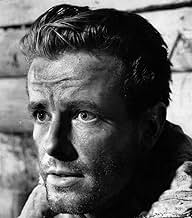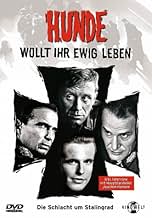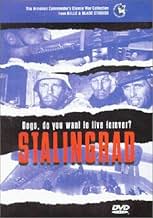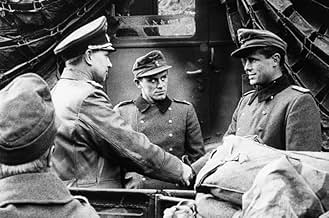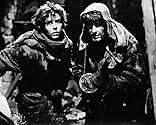IMDb RATING
7.2/10
884
YOUR RATING
In the winter of 1943, against the background of battle scenes, a young German Lieutenant who increasingly distrusts the inhuman Nazi ideology struggles with the concept of war.In the winter of 1943, against the background of battle scenes, a young German Lieutenant who increasingly distrusts the inhuman Nazi ideology struggles with the concept of war.In the winter of 1943, against the background of battle scenes, a young German Lieutenant who increasingly distrusts the inhuman Nazi ideology struggles with the concept of war.
- Awards
- 3 wins & 3 nominations total
Featured reviews
Made soon after the few survivors of Stalingrad returned home, wounds were still fresh & deep when this film was released just 14 years after the unconditional surrender. This film is important because was one of the first German post-war films to critically examine some very difficult & painful areas for the Germans.
Interestingly we never see Hitler's face - I'm sure there are a few reasons for that. The film addresses the lie that the Allies of Germany, Rumania (and Italy et al for that matter) were poor troops. They were good soldiers but were indeed poorly equipped & supported.
There have been criticisms for mis-matching of stock footage, incorrect tanks (T-34/86 instead of T-34/76) & subtitling. Most of this is minor, for example mistaking "Oberst-Leutenant" (Lt-Col) for "Oberleutenant" (Snr Lt) and mis-spelling General Hoth's name (as "Hooth"). The translating of "break-out" as "break ranks" is trivial. The actual footage spliced in may be of different battles but given the time & place this was made it seems a reasonable thing to do. In the end, getting squashed by a Russian tank or disintegrated by high explosive shells is much the same experience wherever you do it.
No, 14 years was not long enough for a deep introspection but this film made a solid start down that path. Well worth seeing. Look out for the exceedingly & implausibly beautiful Sonja Ziemann.
Interestingly we never see Hitler's face - I'm sure there are a few reasons for that. The film addresses the lie that the Allies of Germany, Rumania (and Italy et al for that matter) were poor troops. They were good soldiers but were indeed poorly equipped & supported.
There have been criticisms for mis-matching of stock footage, incorrect tanks (T-34/86 instead of T-34/76) & subtitling. Most of this is minor, for example mistaking "Oberst-Leutenant" (Lt-Col) for "Oberleutenant" (Snr Lt) and mis-spelling General Hoth's name (as "Hooth"). The translating of "break-out" as "break ranks" is trivial. The actual footage spliced in may be of different battles but given the time & place this was made it seems a reasonable thing to do. In the end, getting squashed by a Russian tank or disintegrated by high explosive shells is much the same experience wherever you do it.
No, 14 years was not long enough for a deep introspection but this film made a solid start down that path. Well worth seeing. Look out for the exceedingly & implausibly beautiful Sonja Ziemann.
Wolfgang Preiss, a 2nd reason why i got this plays solitaire while his men die for nothing. I love this movie and watch it every winter on our coldest blustery blizzard day. Unless we have an ugly winter it does not get watched at all. It shows how human the Germans were, how they were not all Nazis. Hitler & the uppers all deserved to die. They had banquets while these men starved & froze. I can't watch it for long usually because it breaks my heart to see them suffer. However i got this for Horst Frank, Wolfgang Preiss, Wilhelm Borchet, Joachim Hansen and Rev. Busch later became a goon after i saw this. He's so sweeet. Somehow garnished the nickname Busch-Busch but one of my sweetest German actors.
Hunde, wollt ihr ewig leben (Dogs, do you want to live forever?) Is directed by Frank Wisbar and adapted to screenplay by Wisbar, Frank Dimen and Heinz Schröter from the Fritz Wöss novel. It stars Joachim Hansen, Wilhelm Borchert, Wolfgang Preiss and Carl Lange. Music is by Herbert Windt and cinematography by Helmut Ashley.
It was a hell hole pocket.
A little cracker jack of a war movie, coming at things from a German's point of view during the Battle of Stalingrad. Through the eyes of our protagonist we come to be part of his disillusionment with the Nazi ways, we witness cowardly majors and obstinate leaders who left the German troops and their allies ill equipped to fight the battle.
A bitter Xmas present.
As Hermann Göring preaches from his pulpit, many miles away from the battle, he's celebrating the 10th anniversary of The Third Reich, all while Stalingrad burns and his army lie dying or limbless in a makeshift grungy hospital. The impact is enough to sicken you to your stomach.
Away from the anti-war thematic thrusts of the narrative, battle scenes are niftily constructed (though some of the spliced footage is incorrect to this battle). While the monochrome photography is in turns gorgeous and then potent to the horrors of war. Splendidly performed by the principals as well.
As has been noted by others who have reviewed this little seen film, the subtitles are poor. Too fast to read sometimes while any language not in German (Eastern Europeans) isn't catered for. A shame, but in the wake of what a very good film this is, it's a small price to pay. 8/10
It was a hell hole pocket.
A little cracker jack of a war movie, coming at things from a German's point of view during the Battle of Stalingrad. Through the eyes of our protagonist we come to be part of his disillusionment with the Nazi ways, we witness cowardly majors and obstinate leaders who left the German troops and their allies ill equipped to fight the battle.
A bitter Xmas present.
As Hermann Göring preaches from his pulpit, many miles away from the battle, he's celebrating the 10th anniversary of The Third Reich, all while Stalingrad burns and his army lie dying or limbless in a makeshift grungy hospital. The impact is enough to sicken you to your stomach.
Away from the anti-war thematic thrusts of the narrative, battle scenes are niftily constructed (though some of the spliced footage is incorrect to this battle). While the monochrome photography is in turns gorgeous and then potent to the horrors of war. Splendidly performed by the principals as well.
As has been noted by others who have reviewed this little seen film, the subtitles are poor. Too fast to read sometimes while any language not in German (Eastern Europeans) isn't catered for. A shame, but in the wake of what a very good film this is, it's a small price to pay. 8/10
This unfairly obscure early German World War II movie has a lot going for it. For one, it has a solid cast with a lot of recognizable German actors who went on to be in a lot of international productions (namely Preiss and Frank) and put in some solid performances here as soldiers trapped in a hopeless battle.
There's a solid share of action with everything on display from the Romanian units crumbling under tank assault to General von Manstein's attempt at relieving the pocket to the bitter street fighting up to the end. Actually the street fighting comes off even better than in STALINGRAD and ENEMY AT THE GATES and feels quite authentic and realistic despite the low budget. Maybe it's because a good share of the actors in the film actually served in the war? I assume the producers were able to find a section of a German city still devastated from the war some 14 years later or else it's some very good set design. Either way I'm impressed. Amazingly, they even managed to round up some real hardware with at least two real T-34's and a PAK anti tank gun for the battle scenes.
The film takes the ingenious step of using authentic stock footage to supplement the battle scenes as was possible only back when films were black and white. This trick also worked well in ITALIANI BRAVA GENTE which also managed to often call into doubt whether the combat footage was original or stock.
The only main detractor is a lot of mismatched stock footage often from entirely different battles (including some now-famous shots of the retreat from Moscow) and during different times of the year (winter to summer and back again). The film tries to play it off by making it look like snow doesn't hit until after the Russians cut off Stalingrad, but anyone with a basic knowledge of WW2 history should know better. Also the tanks are off, with T34/85's appearing too early in the war as usual and a rare case where an IS2 briefly subs in for a German tank of some sort. Mostly minor nitpicks considering that the film's budget was so low. It's amazing what they were able to pull off with such scant resources.
There's a solid share of action with everything on display from the Romanian units crumbling under tank assault to General von Manstein's attempt at relieving the pocket to the bitter street fighting up to the end. Actually the street fighting comes off even better than in STALINGRAD and ENEMY AT THE GATES and feels quite authentic and realistic despite the low budget. Maybe it's because a good share of the actors in the film actually served in the war? I assume the producers were able to find a section of a German city still devastated from the war some 14 years later or else it's some very good set design. Either way I'm impressed. Amazingly, they even managed to round up some real hardware with at least two real T-34's and a PAK anti tank gun for the battle scenes.
The film takes the ingenious step of using authentic stock footage to supplement the battle scenes as was possible only back when films were black and white. This trick also worked well in ITALIANI BRAVA GENTE which also managed to often call into doubt whether the combat footage was original or stock.
The only main detractor is a lot of mismatched stock footage often from entirely different battles (including some now-famous shots of the retreat from Moscow) and during different times of the year (winter to summer and back again). The film tries to play it off by making it look like snow doesn't hit until after the Russians cut off Stalingrad, but anyone with a basic knowledge of WW2 history should know better. Also the tanks are off, with T34/85's appearing too early in the war as usual and a rare case where an IS2 briefly subs in for a German tank of some sort. Mostly minor nitpicks considering that the film's budget was so low. It's amazing what they were able to pull off with such scant resources.
10wuf0170
This refers to the English subtitled release of this film.
This film deals with a tragic defeat and the destruction of the 6th Army at Stalingrad. It was produced shortly after the German POWs taken at Stalingrad had returned home, so had to deal with a critical and knowledgeable audience. It also walked a tightrope, delivering an anti-war message and condemning German leadership in a country which was sick unto death of finger pointing and criticism.
The events in the film take place over more than four months. In order to tell the story coherently, the film shifts focus from narrative to vignette. As the story nears its end, the focus narrows and remains with the troops trapped in Stalingrad, starving and written off by Hitler. All in all, it is well told and the acting is quite good.
On the downside, whoever did the subtitles could have done a better job. I speak German and seeing the subtitles while hearing the dialog and knowing a bit of the history created a bit of a dissonance. General Hoth's name is repeatedly written "Hooth", breakout (as in a breakout from the encirclement) is translated as "Breaking ranks," OberLeutnant (1st Lieutenant) is written as "Lieut. Col.", and when von Paulus uses the word Meuterie (Mutiny), it is translated as disobedience. I suspect that those who are familiar with the history of the battle for Stalingrad and military ranks, but who don't speak German, may have a bit of a problem. these problems with the subtitles led me to give this movie 4 instead of 5 stars.
Still, the story is well told and survives the translator's bludgeon. I was left wanting a bit more. Few films these days manage that.
This film deals with a tragic defeat and the destruction of the 6th Army at Stalingrad. It was produced shortly after the German POWs taken at Stalingrad had returned home, so had to deal with a critical and knowledgeable audience. It also walked a tightrope, delivering an anti-war message and condemning German leadership in a country which was sick unto death of finger pointing and criticism.
The events in the film take place over more than four months. In order to tell the story coherently, the film shifts focus from narrative to vignette. As the story nears its end, the focus narrows and remains with the troops trapped in Stalingrad, starving and written off by Hitler. All in all, it is well told and the acting is quite good.
On the downside, whoever did the subtitles could have done a better job. I speak German and seeing the subtitles while hearing the dialog and knowing a bit of the history created a bit of a dissonance. General Hoth's name is repeatedly written "Hooth", breakout (as in a breakout from the encirclement) is translated as "Breaking ranks," OberLeutnant (1st Lieutenant) is written as "Lieut. Col.", and when von Paulus uses the word Meuterie (Mutiny), it is translated as disobedience. I suspect that those who are familiar with the history of the battle for Stalingrad and military ranks, but who don't speak German, may have a bit of a problem. these problems with the subtitles led me to give this movie 4 instead of 5 stars.
Still, the story is well told and survives the translator's bludgeon. I was left wanting a bit more. Few films these days manage that.
Did you know
- GoofsGerman soldiers carry the Yugoslavian M56 submachine gun instead of the MP40. Yugo M56s are basic copies of the German design, but there are subtle but noticeable differences, such as the long smooth barrel.
- How long is Stalingrad: Dogs, Do You Want to Live Forever??Powered by Alexa
Details
- Release date
- Country of origin
- Language
- Also known as
- Stalingrad: Dogs, Do You Want to Live Forever?
- Filming locations
- Production company
- See more company credits at IMDbPro
Box office
- Budget
- DEM 2,000,000 (estimated)
- Runtime1 hour 33 minutes
- Color
- Sound mix
- Aspect ratio
- 1.66 : 1
Contribute to this page
Suggest an edit or add missing content

Top Gap
By what name was Chiens, à vous de crever ! (1959) officially released in India in English?
Answer

